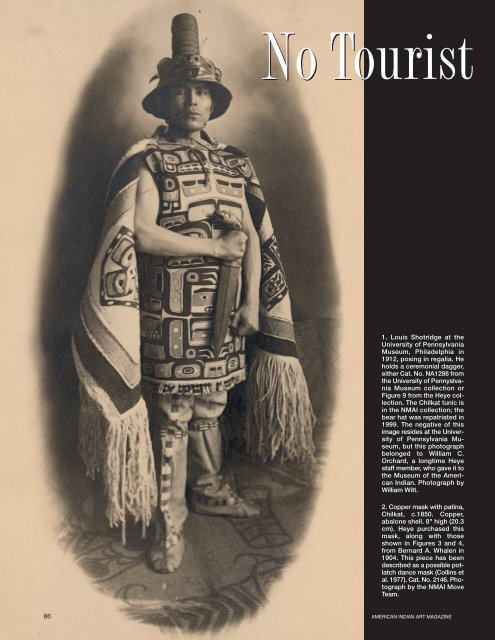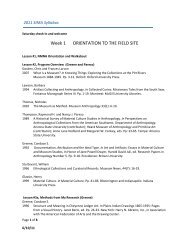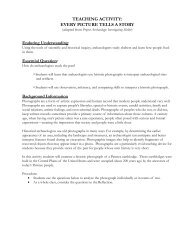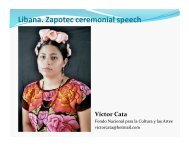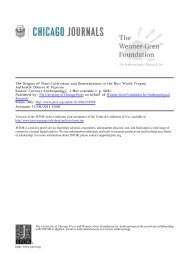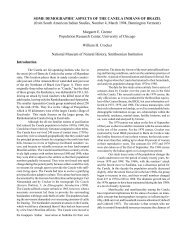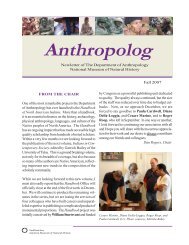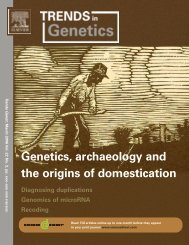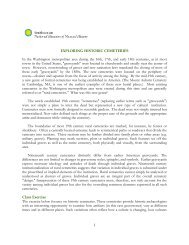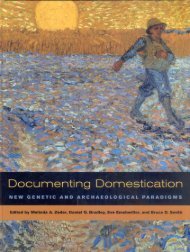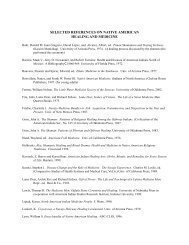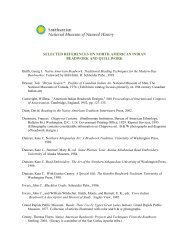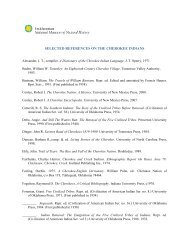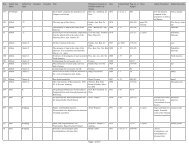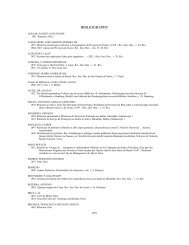No Tourist - Anthropology - Smithsonian Institution
No Tourist - Anthropology - Smithsonian Institution
No Tourist - Anthropology - Smithsonian Institution
Create successful ePaper yourself
Turn your PDF publications into a flip-book with our unique Google optimized e-Paper software.
<strong>No</strong> <strong>Tourist</strong><br />
1. Louis Shotridge at the<br />
University of Pennsylvania<br />
Museum, Philadelphia in<br />
1912, posing in regalia. He<br />
holds a ceremonial dagger,<br />
either Cat. <strong>No</strong>. NA1288 from<br />
the University of Pennyslvania<br />
Museum collection or<br />
Figure 9 from the Heye collection.<br />
The Chilkat tunic is<br />
in the NMAI collection; the<br />
bear hat was repatriated in<br />
1999. The negative of this<br />
image resides at the University<br />
of Pennsylvania Museum,<br />
but this photograph<br />
belonged to William C.<br />
Orchard, a longtime Heye<br />
staff member, who gave it to<br />
the Museum of the American<br />
Indian. Photograph by<br />
William Witt.<br />
2. Copper mask with patina,<br />
Chilkat, c.1850. Copper,<br />
abalone shell. 8" high (20.3<br />
cm). Heye purchased this<br />
mask, along with those<br />
shown in Figures 3 and 4,<br />
from Bernard A. Whalen in<br />
1904. This piece has been<br />
described as a possible potlatch<br />
dance mask (Collins et<br />
al. 1977). Cat. <strong>No</strong>. 2146. Photograph<br />
by the NMAI Move<br />
Team.<br />
86 AMERICAN INDIAN ART MAGAZINE
In April 1904, in the early years of a collecting career that would<br />
become a lifetime passion, the New York collector George G.<br />
Heye purchased eighty-four <strong>No</strong>rthwest Coast and Eskimo objects<br />
from a Los Angeles dealer, Bernard A. Whalen of Alaskan Indian<br />
Curios. Of particular interest, and the focus of this article, is an<br />
assortment of masks, rattles, bracelets, feast spoons and daggers<br />
with elaborate pommels, all made of copper or a combination of<br />
copper and sheep or musk ox horn. These copper and horn pieces<br />
are something of an anomaly in that, though many of them have<br />
an aged appearance, they seem to be unknown in Tlingit collections<br />
made before around 1900. Furthermore, although<br />
Tlingit artists used copper extensively as decorative<br />
elements on masks, rattles, daggers and headdresses,<br />
the creation of a single object entirely<br />
of copper was extremely rare; large pieces<br />
were customarily used throughout the<br />
<strong>No</strong>rthwest Coast only for the ceremonial<br />
“coppers,” of which there are a number<br />
in early museum collections.<br />
Several museums have copper<br />
pieces that are strikingly similar to<br />
the Whalen objects. 1 Some of them<br />
are, or have been, in private collections<br />
and are published on a<br />
fairly regular basis in auction<br />
catalogs, where their estimated<br />
prices run well into five figures.<br />
2 Material: George Heye<br />
& His Golden Rule<br />
Mary Jane Lenz<br />
The available documentation<br />
on these pieces<br />
seems to be scarce or fictitious,<br />
but a number of them<br />
appear to be associated<br />
with three places in the<br />
homeland of the northern<br />
Tlingit people — the Gold<br />
Rush community of Skagway;<br />
the town of Haines, which had a<br />
Presbyterian mission and a<br />
school as early as 1880; and the<br />
village of Klukwan, which was<br />
known as the wealthiest and most<br />
remote of all Tlingit towns in Alaska.<br />
Several pieces also seem to have<br />
some association with Louis Situwuka<br />
Shotridge (b.1882[?], d.1937), who became<br />
AUTUMN 2004<br />
87
the first Native American museum curator, collecting<br />
important Tlingit regalia for the University of Pennsylvania<br />
Museum, in Philadelphia, during his twenty-year<br />
(1912–1932) career there (Mason 1960; Milburn 1986;<br />
Seaton 2000).<br />
The intent of this article is to review the available<br />
information about the Whalen pieces as well as similar<br />
objects elsewhere, to consider them within the context<br />
of Heye’s collecting practices and to situate them within<br />
the genre of native art “made for sale,” which has<br />
become an increasingly important area of study since<br />
Graburn’s seminal 1976 publication (Graburn 1 976;<br />
Wyatt 1984; Lee 1991, 1999; Phillips 1995; Phillips and<br />
Steiner 1999).<br />
Heye’s Whalen purchase was by no means his first<br />
encounter with a dealer. Although his collecting career<br />
had begun with a one-on-one transaction during which<br />
he purchased a deerskin shirt from its maker in Kingman,<br />
Arizona, he had been buying at Covert’s Indian<br />
Store in New York for years and was to develop lifelong<br />
relationships with dealers such as J. D. Standley in<br />
Seattle, Washington, Julius Carlebach in New York and<br />
W. O. Oldman in London, to name only a few. 3 But the<br />
Whalen purchase was described in one museum history<br />
as “the nucleus of the Heye collection” (NMAI Archives<br />
Box OC276#12), and marked Heye’s transition from an<br />
enthusiastic hobbyist to a serious museum colector. He<br />
had, the previous year, acquired a six-hundred-piece<br />
collection of prehistoric New Mexican pottery from<br />
Henry Hales, and later in 1904 he was to add another<br />
archaeological collection, this time from Arizona. He<br />
was newly acquainted with George H. Pepper of the<br />
American Museum of Natural History, New York, and<br />
with Marshall Saville, a professor of American archaeology<br />
at Columbia University, New York, who had taught<br />
him the importance of systematic collecting and scientific<br />
recording. And he was almost certainly purchasing<br />
these ethnographic objects to add to what he envisioned<br />
as a scientific collection of traditional native-made material,<br />
intended for the education of a nonacademic audience<br />
(Museum of the American Indian–Heye Foundation<br />
1916).<br />
Heye’s interest in these copper and horn objects<br />
seems to have persisted through the succeeding decades.<br />
In 1916, the year the Museum of the American<br />
Indian–Heye Foundation was founded in New Y ork,<br />
Heye acquired a large feast spoon made of copper and<br />
horn (Fig. 10). In 1918 Fred Harvey sold him another<br />
copper dagger and rattle (Figs. 6, 13). In 1926 William<br />
Wildschut collected for Heye a copper mask recorded<br />
as “purchased in Holland.” 4 And finally, in 1947 Heye<br />
purchased another copper mask from his old friend<br />
Joseph Keppler (Fig. 11).<br />
Like many museum collectors of his time, Heye<br />
was primarily interested in old pieces, not new ones.<br />
He maintained this standard for years; in 1 917, as<br />
Donald Cadzow was preparing for his first collecting<br />
trip to Alberta and the Mackenzie River, he carefully<br />
recorded as an aide-memoire what he referred to as<br />
“Mr. Heye’s ‘My Golden Rule’”:<br />
Every object collected add field tag.<br />
Material must be old.<br />
Hunting outfits<br />
Fishing outfits<br />
costumes<br />
masks and ceremonial objects, also dance objects<br />
household utensils particularly stone and pottery dishes and<br />
lamps<br />
Talismans, hunting charms, all ivory carvings (old)<br />
NO TOURIST MATERIAL<br />
The copper pieces from Whalen fit the criteria for Heye’s<br />
collection: everything was identified by tribe (Tlingit,<br />
Haida, Chilkat), and many pieces by iconography (Thunderbird,<br />
Bear or “Kotts,” Mountain Sheep); they all suggest<br />
“traditional” or “ceremonial” contexts — masks,<br />
rattles, chiefs’ daggers; they incor porated lavish, or<br />
exclusive, use of copper, a material that was associated<br />
throughout the coast with wealth, prestige and supernatural<br />
power (Levi-Strauss 1982); and for the most part<br />
they showed a deep, sometimes green, patina suggesting<br />
a long period of use. The few exceptions, some<br />
brightly polished copper and silver spoons with animal<br />
crest designs, were catalogued as “Modern-1904.” One<br />
of the daggers (Fig. 8), an iron knife with a copper handle,<br />
included the information that it came “from Koo-deue-how<br />
at Klukwan.” This is probably a reference to “Chief<br />
Coudawot,” who appears in a widely published 1895<br />
Winter and Pond photograph standing next to Yeilgooxu<br />
(English name George Shotridge), Louis Shotridge’ s<br />
father and hereditary chief of the famous Whale House of<br />
Klukwan. 5<br />
The accession information for the Whalen pieces<br />
was entered on Heye’ s catalog cards in his careful<br />
script. (He kept three sets and recorded all the information<br />
himself, as well as numbering each object.) In this<br />
case, rather than stating the origin of the objects as<br />
“from Alaska Indian Curios,” his attribution was “collected<br />
by B. A. Whalen.” This was his usual means of<br />
obscuring the origin of objects from a shop, but was perhaps<br />
not unusual among collectors of the time. Rather<br />
than the “Ye Olde Curiosity Shop, Seattle,” “The Nugget<br />
Shop, Juneau” or “W. O. Oldman, Ethnographic Specimens,<br />
London,” Heye’ s preference was to describe<br />
pieces as “J. D. Standley collection,” “collected by Belle<br />
Simpson,” or “purchased from W. O. Oldman.” 6<br />
Heye died in 1 957, but Director and Curator<br />
Frederick Dockstader added more pieces to the copper<br />
collection and in the 1960s devoted one whole exhibition<br />
case at the museum in Upper Manhattan to a display of<br />
<strong>No</strong>rthwest Coast copper. There were two outstanding<br />
pieces acquired at this time — one was a copper rattle<br />
said to have belonged to Chief Shakes and acquired by<br />
Judge Nathan Bijur during his work in Alaska. 7 Bijur was<br />
the federal judge who officiated at the 1867 raising of the<br />
American flag in Sitka at the time that Alaska’s purchase<br />
88 AMERICAN INDIAN ART MAGAZINE
3. Mask depicting a mosquito, Klukwan (attributed),<br />
c.1904. Copper, abalone shell. 8 1 ⁄2" high, 14" wide<br />
(21.6 cm x 35.6 cm). Heye purchased this mask, along with those shown in Figures 2 and 4, from<br />
Bernard A. Whalen in 1904. According to Aaron Shugar, this mask was molded from a simple face form,<br />
then the nose was folded inside and the mosquito nose was added. The sun rays were attached to the<br />
back with rivets, and the engraved designs were done by hand (Shugar 2004). <strong>No</strong>te the similarity of the<br />
eyebrows to those in Figure 4. Cat. <strong>No</strong>. 6981. Photograph by the NMAI Move Team.<br />
4. Copper mask depicting Thunderbird, with a heavy patina, Tlingit, c.1904.<br />
7" long (17.8 cm). Copper, abalone shell. Heye purchased this mask, along<br />
with those shown in Figures 2 and 3, from Bernard A. Whalen in 1904. Cat.<br />
<strong>No</strong>. 2873. Photograph by the NMAI Move Team.<br />
AUTUMN 2004<br />
5. Mask representing a brown bear, Tlingit, c.1904. Copper,<br />
abalone shell, bear fur, mountain goat–horn teeth.<br />
16" long (40.6 cm). This mask was in the 1973 Masterworks<br />
exhibition at the Metropolitan Museum of Art, New<br />
York, where it was recorded as “Presented by Morton D.<br />
May.” Four other masks of this type have been published.<br />
Cat. <strong>No</strong>. 24/3149. Photograph by the NMAI Move Team.<br />
89
6. Dagger representing human face, heavily patinated, Tlingit,<br />
c.1895. Copper, abalone shell, wood, leather. 15 3 ⁄4" long<br />
(40 cm). Heye purchased this piece from Fred Harvey<br />
in 1918. It is recorded as having been made<br />
by Charles “Shortridge,” undoubtedly<br />
Shotridge. Cat. <strong>No</strong>. 8/1882. Photograph<br />
by the NMAI Move Team.<br />
8. Iron dagger with copper handle, Chilkat, c.1904. Iron,<br />
copper, leather binding on pommel. 22 1 ⁄2" (57.1 cm). Heye<br />
purchased this piece from Bernard A. Whalen in 1904. The<br />
catalog information states that this dagger was obtained<br />
from Koo-deu-e-how at Klukwan. Cat. <strong>No</strong>. 2199. Photograph<br />
by Ernest Amoroso.<br />
9. Eagle dagger, Tlingit, c.1904. Copper, musk ox horn,<br />
abalone shell, leather. 20" long (50.8 cm). Heye purchased<br />
this piece from Bernard A. Whalen in 1904. Witthoft and<br />
Eyman described this dagger as having a native copper<br />
blade and a pommel carved from musk ox horn, depicting an<br />
eagle (1969). The eagle has a movable tongue fastened with<br />
a copper pivot. A similar dagger with a wolf pommel is at<br />
the University of Pennsylvania Museum, Philadelphia as part<br />
of the collection that George B. Gordon purchased in Portland<br />
(Cat. <strong>No</strong>. NA1288), and is reported to be the one Louis<br />
Shotridge is holding in his formal portrait (Fig. 1), though I<br />
believe that he is holding the dagger shown here. Cat. <strong>No</strong>.<br />
4630. Photograph by Ernest Amoroso.<br />
7. Copper dagger with pommel<br />
of human face surrounded<br />
by a sunburst, heavily patinated,<br />
Haida, c.1904. Copper,<br />
abalone shell, leather. 20" long (50.8<br />
cm). Heye acquired this piece from Bernard A.<br />
Whalen in 1904. A comparable copper dagger at the<br />
University of Pennsylvania Museum, Philadelphia (Cat. <strong>No</strong>.<br />
NA1286) has a rattle head. This dagger does not, but the head has<br />
a small hole at the bottom, and it is possible that if tiny stones were<br />
used in the rattle they have been lost. Cat. <strong>No</strong>. 4631. Photograph<br />
by the NMAI Move Team.<br />
from Russia was formalized. This would date the rattle to<br />
the middle of the nineteenth century. The second piece,<br />
a mask (Fig. 5), was obtained from Morton D. May of the<br />
May Company, a Los Angeles department store. The catalog<br />
number indicates that it was accessioned in 1969,<br />
but it was likely part of a 1967 exchange during which May<br />
acquired the Wildschut mask (see footnote 4).<br />
Bernard A. Whalen, of Alaska Indian Curios, was a<br />
dealer who divided his time between Los Angeles during<br />
the winter months and Skagway during the spring and<br />
summer. 8 He was thus well positioned to profit from the<br />
Alaskan tourist business, which was booming by this<br />
time. 9 Skagway, which had begun as a tent city during<br />
the Klondike Gold Rush, was a prosperous frontier town<br />
by 1904, serving as a railway point for the White Pass and<br />
Yukon Railway. Among other businesses, it boasted at<br />
least five curio stores, as well as a number of shops that<br />
seem to have sold curios as a sideline along with drugs,<br />
household furnishings and jewelry (Spude n.d.:141–161).<br />
One of the jewelry stores, owned by P. E. Kern, offered<br />
jewelry, watches and silverware, and had an Indian Art<br />
Department highlighting goods “made by Alaska Indians”<br />
(Fig. 14). Kern’s advertisements in the Daily Alaskan<br />
showed photographs of a well-appointed shop featuring<br />
not only pocket watches, silverware and china, and silver<br />
and gold jewelry, but also an Indian Art Department<br />
that sold “copper pot latch spoons,” a “Witch doctor’s rattle”<br />
and household accouterments, such as copper trays,<br />
paper knives and belt buckles. Many of them were decorated<br />
with swastikas, which Kern presented as an<br />
emblem of good luck. One of his workmen, a man named<br />
Kasko, was pictured in an advertisement that told a purported<br />
legend of the origin of the swastika, ostensibly<br />
derived from the “Alaskan Indian” word “Sha-da-ya-ka.”<br />
This seems to have been highly successful as a<br />
marketing strategy, and a photograph taken around<br />
1905 shows a workshop with at least a dozen workers,<br />
some of whom appear to be native and others Euro-<br />
American. 10 Kern evidently realized that the tourist experience<br />
required Alaskan souvenirs to be “the real thing,”<br />
that is, actually created by native artists.<br />
90 AMERICAN INDIAN ART MAGAZINE
Kern’s operation was noted by George T. Emmons,<br />
the most prolific collector of <strong>No</strong>rthwest Coast objects,<br />
who was impressed by the high quality of the work. He<br />
commented on the “Chilkat, expert metal workers, [who]<br />
obtained copper plating and made wonderful masks,<br />
rattles, spoons, and bracelets...following the old<br />
designs, and aged them to a dark, dull green...I found<br />
that they were all in the hands of a curio dealer in California<br />
who had formerly been in the same business in<br />
Skagway. Through an agent there he had delivered both<br />
the metal and the haliotis for inlaying” (Emmons<br />
1991:379–380). If Emmons’s assessment is accurate,<br />
Whalen not only sold a portion of Kern’s inventory in Los<br />
Angeles, but may also have supplied him with some of<br />
the raw material for the production of the merchandise.<br />
The Daggers<br />
Heye bought six daggers from Whalen in 1904. They<br />
were the type known as chief ’s daggers or fighting<br />
knives, important signifiers of rank and power , and<br />
noted by outside observers in historical accounts beginning<br />
in the eighteenth century (de Laguna 1972:Pls. 48,<br />
51; La Perouse 1799 in de Laguna 1 972:116). The<br />
pommels of such daggers usually depicted an animal<br />
or other form from nature associated with clan history,<br />
and the tapered metal blades, fashioned from iron, copper<br />
or steel, were shaped with delicacy and skill. The<br />
blades on the six daggers from Whalen have a single<br />
raised “rib” down the center, unlike many of the older<br />
daggers, which have a gracefully fluted blade (Vaughan<br />
and Holm 1982:66–75). The backsides of the blades<br />
are flat rather than slightly curved, as if they had each<br />
been cut out of a single sheet of metal.<br />
Daggers were highly valued, and<br />
it seems unusual for a single dealer to<br />
have such a large number so similar in<br />
appearance and construction. Despite<br />
the similarities, however, Whalen’s daggers<br />
had differing attributions — two Tlingit,<br />
one Chilkat and three Haida. Five had copper<br />
pommels in various degrees of brightness, while<br />
one was made of horn decorated with copper and<br />
abalone shell (Fig. 9) .<br />
Heye added the daggers and the rest of the<br />
Whalen pieces to his ever-growing hoard in storage in<br />
New York. He was by then spending considerable time<br />
in Philadelphia, and had made friends with George B.<br />
Gordon, then curator of American archaeology at the<br />
University of Pennsylvania Museum. (Gordon would<br />
eventually become the museum’ s director.) In 1905<br />
Gordon traveled to Portland, Oregon for the Lewis &<br />
Clark Centennial Exposition, and while there he purchased<br />
three copper daggers that bear a striking resemblance<br />
to the daggers Heye had picked up in Los<br />
Angeles. 11 The source for Gordon’s daggers (as well as<br />
a number of other Tlingit pieces) was Louis Shotridge.<br />
At this time Shotridge was young, around twenty years<br />
AUTUMN 2004<br />
old, not yet settled on a career and in town accompanying<br />
his wife Florence, who was demonstrating the art of<br />
Chilkat weaving at the exposition. She and Louis had<br />
been living at Haines, not far from Klukwan and Skagway,<br />
and Louis brought some pieces from Klukwan to sell at<br />
the exposition. Heye evidently introduced Gordon and<br />
Shotridge (Cole 1985:255), and Gordon purchased fortynine<br />
objects, including the daggers (Milburn 1986:62). 12<br />
Where Heye first met Shotridge is not known, but it<br />
may have been in Los Angeles, possibly at Antonio<br />
Apache’s Indian Crafts Exposition. Florence and Louis<br />
Shotridge were employed there the following year, 1906,<br />
and may have been there previously. The Heye–Gordon<br />
–Shotridge association continued for several years, as<br />
Heye left the banking business and in 1908 deposited<br />
his collection at the University of Pennsylvania Museum,<br />
where Gordon expected it to remain. Shotridge sent<br />
another shipment to Gordon from Los Angeles, this time<br />
including some copper masks as well as knives and<br />
pipes, but Gordon refused most of them because they<br />
were new rather than old (Milburn 1986:63). Shotridge<br />
explained apologetically that everyone, including his<br />
father, thought the knives were good because they were<br />
just like the old ones but that henceforth he would not<br />
send any more copper.<br />
When Shotridge, by now on the University of Pennsylvania<br />
Museum staf f, posed in 1 912 for a photographic<br />
portrait wearing Tlingit regalia from the museum<br />
collection, he chose to carry one of the copper daggers<br />
(Fig. 1). According to Mason (1960:15) it is the wolf dagger<br />
that he had sold to Gordon in 1905 in Portland, but it<br />
looks more like the eagle dagger that Heye purchased<br />
from Whalen (Fig. 9). In any case, Shotridge’s choice of<br />
one of these daggers in a formal portrait of a Tlingit chief<br />
in his finest regalia suggests that, at least to him, the<br />
fact that the dagger was of recent manufacture took<br />
nothing away from its social value, cultural importance or<br />
authenticity.<br />
Heye was to add one more copper dagger to his<br />
collection. In 1918, as one of two copper pieces purchased<br />
from Harvey, he added a dagger with the<br />
10. Feast spoon, Tlingit, c.1904. Copper, wood,<br />
abalone shell, mountain sheep horn. 18" long (45.7<br />
cm). Acquired by Heye in 1916. Witthoft and Eyman<br />
describe it as “ten pieces carved from a pair of<br />
musk-ox horns, attached to the wooden core with<br />
seven copper pins and overlaid with seventeen thin<br />
pieces of native copper set with copper pins. The<br />
bear at the tip of the handle has separate hands and feet<br />
cut from the black tip of the horn, set with four more<br />
copper pins” (1969:19). Cat. <strong>No</strong>. 5/944. Photograph<br />
by the NMAI Move Team.<br />
91
11. Copper<br />
mask, Tlingit.<br />
Copper, abalone<br />
shell. 8" long (20.3<br />
cm). Heye purchased this<br />
mask from Joseph Keppler in 1947.<br />
Cat. <strong>No</strong>. 20/6954. Photograph by Ernest Amoroso.<br />
familiar rib running down the center of the blade and a<br />
pommel of darkened copper adorned with inlaid abalone<br />
shell (Fig. 6). The catalog information for this knife states<br />
“Made about 1895 by Charles Shortridge” (“Shortridge”<br />
is undoubtedly an error; the other Harvey piece, a rattle, is<br />
attributed to “Charles Shotridge”). “Charles” is to date an<br />
unidentified member of the Shotridge family. Perhaps he<br />
was related to George Shotridge, Louis’s father. It is possible<br />
that Charles may have learned some of the techniques<br />
used in Kern’s workshop and supplied Louis with<br />
some of the Klukwan pieces he sold to Gordon.<br />
In 1969 John Witthoft and Frances Eyman, of the<br />
University of Pennsylvania Museum, conducted a study<br />
of the metal in the daggers that Gordon had acquired in<br />
Portland, as well as one of the daggers that Heye had<br />
acquired from Whalen. The question of whether the copper<br />
was from a native source in Alaska or the central<br />
Arctic was not resolved, but Witthoft did postulate that<br />
the darkening of the copper was a result of the blade’s<br />
being covered with fish oil, a substance that caused a<br />
chemical reaction with the copper and would create a<br />
dark patina (Witthoft and Eyman 1969).<br />
More recently, Aaron Shugar, visiting scientist at<br />
the <strong>Smithsonian</strong> Center for Materials Research and<br />
Education, Washington, D.C., examined several of the<br />
pieces and offered the observation that the surfaces<br />
were aged with (his term) a “false corrosion.” Shugar<br />
attributed it to the application of some acid such as a sulfide<br />
but to date analysis of the specific substance has<br />
not been done (2004).<br />
The Masks<br />
Heye purchased three copper masks from Whalen (Figs.<br />
2, 3, 4). He acquired two others later, one in 1926 from<br />
Wildschut (Cat. <strong>No</strong>. 14/9080), and one in 1 947 from<br />
Keppler (Fig. 1 1). A Brown Bear mask acquired by<br />
Dockstader in 1967 was the last copper mask to enter<br />
the NMAI collection (Fig. 5). Most of the masks have<br />
abalone shell inlay depicting the eyes, nostrils or teeth;<br />
only two have eyeholes. They have been interpreted as<br />
potlatch dance masks (Collins et al. 1977) and Dockstader,<br />
who remarked that copper masks are extremely rare, indicated<br />
that they were made of sheet copper (n.d.:Fig.<br />
121). The construction technique seems to be a combination<br />
of hammering sheet copper over a mold, or several<br />
molds, probably made of wood, and then finishing the<br />
piece by riveting ears, noses or head ornaments to the<br />
finished product. 13 The abalone shell or horn inlay, particularly<br />
for the rows of teeth, is secured by a metal backing<br />
riveted to the reverse side of the mask. Several of the<br />
masks are then finished with engraved designs on the<br />
cheeks, the chin or the forehead.<br />
Like the daggers, the presence of three similar copper<br />
masks in one curio shop is unusual. Almost all Tlingit<br />
masks are carved of wood, and most of them were<br />
used by native healers and found in association with<br />
other shamanic equipment. Masks were, however ,<br />
highly popular with collectors, and some masks had<br />
been made for sale as early as the mid-nineteenth century.<br />
When Ensign Albert Niblack visited Alaska in<br />
1885–1887, he commented that “The number of masks<br />
in the collections of the U.S. National Museum is out of<br />
all proportion to their importance or their use by the Indians.<br />
There are only one or two ceremonial dances in<br />
which they are worn, which is quite contrary to the<br />
accepted opinion” (1890:384).<br />
The Brown Bear mask acquired by Dockstader in<br />
the 1967 exchange with May (Fig. 5) appears to be part<br />
of the same “production run” as four other masks that<br />
have been published. Three of them are associated with<br />
the Nugget Shop, Inc.: Curio Dealers, Jewelers, and<br />
Opticians, a well-known Juneau store. The NMAI mask<br />
is attributed to “Ex Coll. Belle Simpson,” the owner of the<br />
Nugget Shop for many years. Dockstader considered<br />
this mask an important acquisition for the museum and,<br />
when he was refurbishing the exhibition cases in the<br />
1960s, he made it the centerpiece of the exhibit case<br />
devoted to <strong>No</strong>rthwest Coast copper. The second “Ex.<br />
Coll. Belle Simpson” mask is listed as depicting a “Sea<br />
Bear” and attributed to “Haida,” first in the Museum of<br />
Primitive Art, New York, and now in the Michael Rockefeller<br />
Wing of the Metropolitan Museum of Art, New York<br />
(Cat. <strong>No</strong>. 58.329). It has been widely published (Collins<br />
et al. 1977:249, Gunther 1962:69, Wardwell 1964:31).<br />
The third “Simpson” mask (Fig. 15) was purchased in<br />
1926 by Ale˘s Hrdlic˘ka of the United States National<br />
Museum in Washington, D.C. (now the <strong>Smithsonian</strong>’s<br />
National Museum of Natural History). While on a visit to<br />
92 AMERICAN INDIAN ART MAGAZINE
Juneau, Hrdlic˘ka purchased a copper mask from Dr.<br />
Robert Simpson, Belle’s husband, and acquired with the<br />
mask the following information: “Ceremonial sheet copper<br />
mask used in mortuary ceremonies (killing of<br />
slaves)...the mask originally came from Yakutat. I have<br />
forgotten the name of the native who brought it in, but it<br />
is a genuine article and is probably the only one in existence...These<br />
were worn by the medicine men at their<br />
various ceremonies” (Hrdlic˘ka 1929:34). Afourth copper<br />
Sea Bear mask, now in the collection of the St. Joseph<br />
Museum, St. Joseph, Missouri, is also published in<br />
Collins et al. (1977:315). According to Sarah Elder, chief<br />
curator of the St. Joseph Museum, the mask was<br />
acquired as part of the George Collection, an assemblage<br />
of some four thousand pieces given to the<br />
museum in 1940. The accession records indicate that<br />
Mr. George began collecting in 1904. It is probably a<br />
coincidence that 1904 is the year that Heye made his<br />
Whalen purchase. The fifth copper mask from the same<br />
mold has appeared twice in Sotheby’s catalogs, the first<br />
time on May 30, 1986 (Lot <strong>No</strong>. 153) and the second on<br />
May 23, 1995 (Lot <strong>No</strong>. 224). Each of the these masks<br />
is finished in a slightly different fashion: some with hair;<br />
some with a great deal of abalone shell inlay and others<br />
with less; and one with teeth made from carved<br />
horn.<br />
Finally, there is a sixth copper mask in the collection<br />
of the Peabody Museum of Archaeology and Ethnology,<br />
Harvard University, Cambridge, Massachusetts<br />
(Vaughan and Holm 1982), depicting a semi-human<br />
eagle or hawk with a distinctive beak/mouth form and<br />
abalone shell–inlaid mouth and eyes that are reminiscent<br />
of the Whalen Thunderbird mask (Fig. 4).<br />
The stylistic and manufacturing similarities among<br />
these copper masks suggest a common origin, despite<br />
the variations in attribution and cultural information. Circumstantial<br />
evidence — including the reasonable proximity<br />
of Klukwan and P. E. Kern’s “native manufactury”<br />
at Skagway, the association of Whalen with both Skagway<br />
and Los Angeles, and the possibility that Louis<br />
Shotridge may have obtained some of his Klukwan<br />
objects-for-sale from a kinsman who was familiar with<br />
Kern’s operation — suggests that the common origin<br />
may have been Kern’s workshop. It is tempting to postulate<br />
that the pieces were in fact produced by the<br />
“skilled Chilkat metalworkers” who worked for Kern. But<br />
Kern’s was not the only curio workshop in Alaska, and<br />
there is tantalizing, sketchy information about at least<br />
one other workshop where a Euro-American merchant<br />
employed native artisans to produce copper masks for<br />
sale to the tourists who visited Alaska in the early part<br />
of the century.<br />
Joseph Chilberg was another merchant/entrepreneur<br />
who came to Alaska to make his fortune. By 1900<br />
he had settled in <strong>No</strong>me and worked as a trader and<br />
dealer in native artifacts collected from the local Alaskan<br />
people, including Inupiat, Athabaskan and possibly vis-<br />
AUTUMN 2004<br />
iting Tlingit. He acquired at least two Anvik wooden<br />
masks now in the NMAI collections (Fienup-Riordan<br />
1996:267). Chilberg is reported to have befriended a<br />
number of local native people and, in an effort to find<br />
profitable work for them, began a workshop where artisans<br />
were employed to make curios to sell to the local<br />
tourists. According to Chilberg’s grandson, who was a<br />
young boy when he heard his grandfather’s stories, copper<br />
masks were one object type manufactured in some<br />
quantity. In this case, the masks were produced by hammering<br />
sheets of copper into the back of a wooden<br />
mold, rather than the front. Chilberg ordered the copper<br />
in sheets from the Phelps-Dodge Company (Rowland<br />
2003). Chilberg was a highly successful dealer in artifacts<br />
in <strong>No</strong>me and may have sold some of the copper<br />
pieces in his own operation. Eventually he moved to<br />
California and became a banker and a collector of<br />
Indian artifacts, but he seems not to have kept any of the<br />
copper masks for his personal collection. It seems likely,<br />
however, that there were other curio dealers and perhaps<br />
similar enterprises throughout Alaska during the<br />
years when the tourist traffic was rapidly becoming a<br />
growth industry.<br />
The Rattles<br />
<strong>No</strong>rthwest Coast rattles, like masks, are primarily made<br />
of wood and, in the south, from sheep horn. Heye collected<br />
only one copper rattle from Whalen (Fig. 12) but<br />
acquired a second one from Harvey (Fig. 13). Dockstader<br />
purchased a third copper rattle in 1965 from a<br />
descendant of Bijur. 14 The collection information states<br />
that it was acquired “by Judge Bijur during his work in<br />
Alaska,” and that it was formerly the property of the<br />
Tlingit chief Shakes of Etolin Island, Alaska. All three<br />
rattles are the round type used by native healers, and<br />
all three show human or animal faces with abalone shell<br />
12. Copper rattle with heavy patina, Haida, c.1904. Copper, abalone<br />
shell, human hair, wood, hide. 11" high (28 cm). Heye purchased<br />
this piece from Bernard A. Whalen in 1904. Cat. <strong>No</strong>. 1087. Photograph<br />
by the NMAI Move Team.<br />
93
13. Rattle representing human face by<br />
Charles Shotridge (attributed), Tlingit, c.1895.<br />
Copper, abalone shell, human hair, wood,<br />
leather. 8 3 ⁄4" long (22.2 cm). Heye purchased<br />
this piece from Fred Harvey in 1918. Cat. <strong>No</strong>.<br />
8/1844. Photograph by the NMAI Move Team.<br />
14. P. E. Kern’s store at Broadway and Fifth Avenue, Skagway,<br />
Alaska, c.1905. Bernard A. Whalen’s store was also on Broadway,<br />
two blocks west. Courtesy of the Skagway Museum, Kern<br />
Collection, Skagway, Alaska.<br />
defining the features and have human hair held in place<br />
by the fastening together of the two halves of the<br />
rattle. The Whalen rattle has a heavy,<br />
dark patina with a greenish cast,<br />
while the other two rattles simply<br />
look darkened with age. Three<br />
other copper rattles have been<br />
published, and all of them have<br />
been in the hands of collectors.<br />
The first, in the collection<br />
of the Autry National Center/Southwest<br />
Museum, Los<br />
Angeles (Cat. <strong>No</strong>. 980.G.131),<br />
was given on behalf of a<br />
collector who died in 1 905<br />
(Inverarity 1950: Fig 126).<br />
The second, published in<br />
Pleasing the Spirits (Ewing<br />
1982:105), was originally<br />
acquired as a gift to “the<br />
Rev. Mr. R. A. Laak [Laak was<br />
the minister at Haines] for services performed<br />
at a small settlement near Haines, Alaska, about<br />
1890.” And the third, published in Soft Gold (Vaughan<br />
and Holm 1 982:Fig. 87) was a gift to the Peabody<br />
Museum of Archaeology and Ethnology, Harvard University,<br />
Cambridge, Massachusetts from Louis Farlow<br />
in 1904. 15 Like the copper bear dagger that Farlow also<br />
gave the Peabody in 1904, the source for the rattle was<br />
Grace Nicholson, the Pasadena, California dealer. The<br />
rattle was accompanied by information explaining that<br />
it was obtained from the nephew of a Chilkoot shaman.<br />
Nevertheless, it looks remarkably like the rest of the<br />
copper rattles and the other copper pieces that Heye<br />
purchased from Whalen.<br />
Conclusion<br />
The production of items usually referred to as curios has<br />
had a long and honorable history on the <strong>No</strong>rthwest Coast.<br />
During Alejandro Malaspina’s 1791 visit to Yakutat Bay, he<br />
reported that “as soon as they discovered the market for<br />
such articles (figurines, spoons, daggers, boxes, etc.),<br />
the Indian men and women began to make them for trade”<br />
(de Laguna 1972, Vol. 1:144). Haida argillite carving, an<br />
enterprise geared to a foreign market, was a full-blown<br />
industry by the 1820s (Sheehan 1981). Rolf Knight’s study<br />
of native people and the labor market in British Columbia<br />
lists “the ethnographic trade,” meaning the production of<br />
both ceremonial and utilitarian items for sale, as an important<br />
means of making a living, alongside occupations such<br />
as commercial fishing and cannery work, logging, crewing<br />
on ships large and small, prospecting, mining and railway<br />
work (Knight 1978). He points out that, at least during<br />
the days of intensive museum and tourist collecting of the<br />
late nineteenth century, many talented carvers were still<br />
working (Wright 2001; Black 1997). Objects such as<br />
masks, rattles and dancing gear were easy to replace and,<br />
94 AMERICAN INDIAN ART MAGAZINE
except for clan treasures, were freely sold (Oberg 1973).<br />
The question of the authenticity of objects made for<br />
sale was perhaps of more concern to the people who<br />
purchased curios than to the artists who made them.<br />
Producing art for sale — particularly curios such as copper<br />
masks and rattles, which were traditional objects<br />
made of nontraditional materials — may have allowed<br />
the native artists a degree of freedom to embellish their<br />
work in new ways. Certainly some of the copper objects<br />
produced for sale are of great beauty and have been<br />
displayed in more than one masterworks exhibition<br />
(e.g., Gunther 1962). The 1890 report on Alaska’s tourist<br />
trade took a different view, stating that<br />
All carvings...originally manufactured for their own use by the<br />
natives have long since been sold...The people of several villages<br />
devote themselves exclusively to the manufacture of<br />
curios, and several individuals make a specialty of producing<br />
specimens of any degree of antiquity desired. As the excursions...are<br />
expensive and not likely to be repeated...many<br />
years will probably elapse before the general public will<br />
become aware of the imposition, and in the meantime the curio<br />
trade will flourish (Porter 1893:250–251).<br />
The pieces that Heye purchased in 1904 are now a century<br />
old. Perhaps we can begin to think of them, and<br />
pieces like them, in a new way; rather than thinking of<br />
them as curios they can be thought of as precursors to<br />
the work of contemporary native artists such as Preston<br />
Singletary (Tlingit), Joe Fedderson (Colville) and Susan<br />
Point (Coast Salish), who create traditional forms in nontraditional<br />
media. Heye’s prodigious collection is the<br />
foundation for the new National Museum of the American<br />
Indian. It will pay tribute to all native artists, ancient<br />
and modern, who worked with materials old and new to<br />
create many kinds of artistic expression.<br />
Footnotes<br />
1 These include the University of Pennsylvania Museum, Philadelphia; the Metropolitan<br />
Museum of Art, New York; the Peabody Essex Museum, Salem,<br />
Massachusetts; the Peabody Museum of Archaeology and Ethnology, Harvard<br />
University, Cambridge, Massachusetts; the Autry National Center/Southwest<br />
Museum, Los Angeles; and the St. Joseph Museum, St. Joseph,<br />
Missouri. There are others undoubtedly.<br />
2 As just a few examples see Sotheby’s, April 24, 1982, Lot <strong>No</strong>s. 477 and 478;<br />
and Sotheby’s, May 30, 1986, Lot <strong>No</strong>s. 152, 153 and 154. Two of the 1986<br />
pieces reappeared at Sotheby’ s, May 23, 1995, Lot <strong>No</strong>s. 224 and 225.<br />
Sotheby’s auction of December 4, 1993 included a dagger, Lot <strong>No</strong>. 175,<br />
which is very similar to the one in Figure 8. Sotheby’s catalog of October<br />
26, 1979 has a copper and sheep-horn shark dagger, Lot <strong>No</strong>. 359, which<br />
appears (and may be) identical to W. E. Channing & Co.’s shark dagger in an<br />
advertisement in the Winter 1992 issue of this magazine. A third shark dagger<br />
and a copper rattle are published in Pleasing the Spirits (Ewing 1982:<br />
Figs. 128 and 45). The rattle is very much like the one shown on the cover<br />
of this issue, as well as one in the Southwest Museum, Cat. <strong>No</strong>. 980.G.131.<br />
(The rattle from the Southwest Museum was published in Inverarity [1950] as<br />
Fig. 126 but the number there is incorrect.)<br />
3 Covert’s Indian Store on lower Fifth A venue was also known as Covert<br />
& Harrington, Commercial Ethnologists. The letterhead promised “Collections<br />
illustrating American Indian Life for schools and colleges. Museums supplied<br />
with authentic material.” The “Harrington” in the firm was Mark Raymond<br />
Harrington, a young Columbia University graduate who in time would become<br />
one of Heye’s most indefatigable collectors.<br />
4 This mask was exchanged with Morton D. May in 1967 and, according to<br />
Curator Gretchen Faulkner, is now in the collection of the Hudson Museum,<br />
University of Maine, Orono.<br />
5 According to de Laguna, Coudawot was a chief of the Raven 3 (Ga naxte di)<br />
clan at Klukwan (1972). Another Winter & Pond image of Coudawot, inside the<br />
Whale House at Klukwan, is in Wyatt (1989:119). A photograph of Coudawot<br />
on his deathbed was taken by George T . Emmons and is published in<br />
Emmons (1991:271).<br />
AUTUMN 2004<br />
15. Mask, Tlingit, c.1904. Copper, abalone shell, bear fur. 16" long<br />
(40.6 cm). Acquired by Alĕs Hrdlic˘ka in Juneau, Alaska in 1926 from<br />
the Nugget Shop, Inc.: Curio Dealers, Jewelers, and Opticians. Its<br />
origin is given as Yakutat, Alaska, and the catalog information states<br />
that it was as “worn by the medicine men at their various ceremonies<br />
and particularly when they killed the slaves at the potlatches.”<br />
Hrdlic˘ka purchased it specifically for the United States<br />
National Museum. Courtesy of the National Museum of Natural History,<br />
<strong>Smithsonian</strong> <strong>Institution</strong>, Washington, D.C. Cat. <strong>No</strong>. 332801.<br />
6 Kate Duncan points out that many more objects in museum collections were<br />
acquired from curio shops than has generally been recognized (2000:94).<br />
7 See cover illustration.<br />
8 Two stories in the Daily Alaskan show the pattern. The <strong>No</strong>vember 2, 1902<br />
issue relates: “B.J. [sic] Whalen is packing up his stock of Indian curios and<br />
his household goods preparatory to leaving for Los Angeles on the next trip<br />
of the Seattle, which is due here Tuesday. Mrs. Whalen and Miss Bernardine<br />
will accompany Mr. Whalen to the Southern California City.” The May 16, 1903<br />
issue notes: “B.A. Whalen began the work of preparing his old place of business<br />
at the corner of Third Avenue and Broadway, yesterday, for occupancy.<br />
He will open his curio store at once.”<br />
9 Cruises up the Inside Passage began in 1882, and by 1890 the Pacific Coast<br />
Steamship Company reported yearly tourist trafic at more than five thousand<br />
with an average ticket price of $100. In addition, more than half of the visitors<br />
spent in excess of $50 to $100 for curios, making a total income for 1890<br />
of more than $2,500,000 (Porter 1893:250–251). Molly Lee has done several<br />
thoughtful analyses of the Alaskan tourist market (1991, 1999).<br />
10Molly Lee shows one view of Kern’s Indian Curio Workshop, from Special Collections,<br />
Baker Library, Dartmouth College, Hanover, New Hampshire (1991).<br />
11The Portland daggers, Cat. <strong>No</strong>s. NA1286, NA1287 and NA1288, are in the<br />
University of Pennsylvania Museum, Philadelphia, and are published in<br />
Kaplan and Barsness (1986) and Witthoft and Eyman (1969).<br />
12One of the Portland daggers (Cat. <strong>No</strong>. NA1286), has a copper pommel<br />
depicting a human or sun face, much like Heye’s piece (Fig. 7). Heye’s piece,<br />
however, is attributed to the Haida. Another, the “ceremonial dagger” depicting<br />
a bear (Cat. <strong>No</strong>. NA1287), is very similar in workmanship and design to<br />
a dagger at the Peabody Essex Museum, Salem, Massachusetts (Cat. <strong>No</strong>.<br />
E28191) and one at the Peabody Museum of Archaeology and Ethnology,<br />
Harvard University, Cambridge, Massachusetts (Cat. <strong>No</strong>. 64029; Collins et al.<br />
1977:335; Wardwell 1964:112). The Peabody Essex Bear dagger was a 1949<br />
bequest, but the Peabody Harvard dagger was acquired by Grace Nicholson,<br />
the Pasadena dealer, and sold to Lewis Farlow, who gave it to Harvard in<br />
1904. It does not seem beyond the realm of possibility that Grace Nicholson<br />
and Bernard Whalen, who were neighboring dealers in Indian artifacts, and<br />
both sold pieces to Heye, were at least aware of each other’s existence.<br />
Whether they were competitors or colleagues I do not know, but it is interesting<br />
to speculate on whether Nicholson picked up a few of the Kern pieces<br />
from Whalen for subsequent resale.<br />
13It appears that some molds may have been for a single, whole mask, while<br />
other masks were created from several molds, which the artist could “mix and<br />
match” as he chose.<br />
14See cover illustration.<br />
15Bill Holm identified this as having been made around 1900, probably for sale<br />
(Vaughan and Holm 1982).<br />
George Heye continued on page 105<br />
95
George Heye continued from page 95<br />
Bibliography<br />
Black, Martha<br />
1997 Bella Bella: A Season of Heiltsuk Art. Douglas & MacIntyre,<br />
Vancouver, British Columbia and Toronto, Ontario.<br />
Cole, Douglas<br />
1985 Captured Heritage: The Scramble for <strong>No</strong>rthwest Coast Artifacts.<br />
University of Washington Press, Seattle.<br />
Collins, Henry B., Frederica de Laguna, Edmund Carpenter<br />
and Peter Stone<br />
1977 The Far <strong>No</strong>rth: 2000 Years of American Eskimo and Indian Art.<br />
Indiana University Press, Bloomington.<br />
Daily Alaskan<br />
1902 <strong>No</strong>vember 2, Daily Alaskan.<br />
1903 May 16, Daily Alaskan.<br />
de Laguna, Frederica<br />
1972 Under Mt. St. Elias: The History and Culture of the Yakutat Tlingit.<br />
<strong>Smithsonian</strong> Contributions to <strong>Anthropology</strong>, 7.<br />
Dockstader, Frederick J.<br />
n.d. Indian Art in America: The Arts and Crafts of the <strong>No</strong>rth American<br />
Indian. Promontory Press, New York.<br />
Duncan, Kate C.<br />
2000 1001 Curious Things: Ye Olde Curiosity Shop and Native American<br />
Art. University of Washington Press, Seattle.<br />
Emmons, George T.<br />
1991 The Tlingit Indians. University of Washington Press, Seattle.<br />
Ewing, Douglas C.<br />
1982 Pleasing the Spirits: A Catalogue of a Collection of American Indian<br />
Art. Ghylen Press, New York.<br />
Fienup-Riordan, Ann<br />
1996 Agayuliyararput: The Living Tradition of Yup’ik Masks. University of<br />
Washington Press, Seattle.<br />
Graburn, Nelson H. H. (editor)<br />
1976 Ethnic and <strong>Tourist</strong> Arts: Cultural Expressions from the Fourth World.<br />
University of California Press, Berkeley.<br />
Gunther, Erna<br />
1962 <strong>No</strong>rthwest Coast Indian Art. Century 21 Exposition, Seattle.<br />
Hrdlic˘ka, Alĕs<br />
1929 Anthropological Survey in Alaska. Bureau of American Ethnology<br />
Annual Report <strong>No</strong>. 46. Washington, D.C.<br />
Inverarity, Robert B.<br />
1950 Art of the <strong>No</strong>rthwest Coast Indians. University of California Press,<br />
Berkeley.<br />
Kaplan, Susan A. and Kristin J. Barsness<br />
1986 Raven’s Journey: The World of Alaska’s Native People. University<br />
Museum, University of Pennsylvania, Philadelphia.<br />
Knight, Rolf<br />
1978 Indians at Work: An Informal History of Native Indian Labour in<br />
British Columbia, 1858–1930. New Star Books, Vancouver, British<br />
Columbia.<br />
La Perouse, Jean Francoise de Galaup, Comte de<br />
1799 AVoyage around the World. London.<br />
Lee, Molly<br />
1991 Appropriating the Primitive: Turn-of-the-Century Collection and<br />
Display of Native Alaskan Art. Arctic <strong>Anthropology</strong>, 28(1):6–15.<br />
1999 Tourism and Taste Cultures: Collecting Native Art in Alaska at the<br />
Turn of the Twentieth Century. In Unpacking Culture: Art and<br />
Commodity in Colonial and Postcolonial Worlds, edited by Ruth B.<br />
Phillips and Christopher B. Steiner, pp. 167–281. University of<br />
California Press, Berkeley.<br />
Levi-Strauss, Claude<br />
1982 The Way of the Masks, translated by Sylvia Modelski. University of<br />
Washington Press, Seattle.<br />
Mason, J. Alden<br />
1960 Louis Shotridge. Expedition, 2(2):10–16.<br />
Milburn, Maureen<br />
1986 Louis Shotridge and the Objects of Everlasting Esteem. In Raven’s<br />
Journey: The World of Alaska’s Native People, edited by Susan A.<br />
Kaplan and Kristin J. Barsness, pp. 54–77. University Museum,<br />
University of Pennsylvania, Philadelphia.<br />
Museum of the American Indian–Heye Foundation<br />
1916 Annual Report. Museum of the American Indian – Heye Foundation,<br />
New York.<br />
Niblack, Albert P.<br />
1890 The Coast Indians of Southern Alaska and <strong>No</strong>rthern British<br />
Columbia. In Annual Report of the United States National<br />
Museum for 1888, pp. 225–386. Government Printing Office,<br />
Washington, D.C.<br />
AUTUMN 2004<br />
Oberg, Kalervo<br />
1973 The Social Economy of the Tlingit Indians. University of Washington<br />
Press, Seattle.<br />
Phillips, Ruth B.<br />
1995 Why <strong>No</strong>t <strong>Tourist</strong> Art: Significant Silences in Native American<br />
Museum Representation. In After Colonialism: Imperial Histories<br />
and Post-Colonial Displacements, edited by Gyan Prakash,<br />
pp. 98–125. Princeton University Press, Princeton, New Jersey.<br />
Phillips, Ruth B. and Christopher B. Steiner (editors)<br />
1999 Unpacking Culture: Art and Commodity in Colonial and Postcolonial<br />
Worlds. University of California Press, Berkeley.<br />
Porter, Robert D.<br />
1893 Report on Population and Resources of Alaska at the Eleventh<br />
Census:1890. Government Printing Office, Washington, D.C.<br />
Rowland, David<br />
2003 Personal communcation.<br />
Seaton, Elizabeth<br />
2000 The Native Collector: Louis Shotridge and the Contests of<br />
Possession. Ethnography, 2(1):35–61.<br />
Sheehan, Carol<br />
1981 Pipes That Won’t Smoke; Coal That Won’t Burn; Haida Sculpture in<br />
Argillite. Glenbow Museum, Calgary, Alberta.<br />
Shugar, Aaron<br />
2004 Personal communication.<br />
Spude, Robert L. S.<br />
n.d. Skagway, District of Alaska 1884–1912: Building the Gateway to the<br />
Klondike. Report prepared as a cooperative effort of the Cooperative<br />
Park Studies Unit, University of Alaska, Fairbanks and the Alaska<br />
Regional Office of the National Park Service, United States<br />
Department of the Interior.<br />
Vuaghan, Thomas and Bill Holm<br />
1982 Soft Gold: The Fur Trade and Cultural Exchange on the <strong>No</strong>rthwest<br />
Coast of America. Oregon Historical Society, Portland.<br />
Wardwell, Allen<br />
1964 Yakutat South Indian Art of the <strong>No</strong>rthwest Coast. Art Institute,<br />
Chicago.<br />
Witthoft, John and Frances Eyman<br />
1969 Metallurgy of the Tlingit, Dene, and Eskimo. Expedition,<br />
11(3):12–23.<br />
Wright, Robin K.<br />
2001 <strong>No</strong>rthern Haida Master Carvers. University of Washington Press,<br />
Seattle.<br />
Wyatt, Victoria<br />
1984 Shapes of Their Thoughts: Reflections of Culture Contact in<br />
<strong>No</strong>rthwest Coast Indian Art. Peabody Museum of Natural History,<br />
Yale University, New Haven, Connecticut and University of<br />
Oklahoma Press, <strong>No</strong>rman.<br />
1989 Images from the Inside Passage: An Alaskan Portrait by Winter &<br />
Pond. University of Washington Press, Seattle with the Alaska State<br />
Library, Juneau.<br />
I want to offer grateful thanks to the following people, all of whom<br />
provided invaluable help and advice in this still-burgeoning project:<br />
Felicia Pickering, Department of <strong>Anthropology</strong>, National Museum of<br />
Natural History, <strong>Smithsonian</strong> <strong>Institution</strong>, Washington, D.C.; Karl Gurke,<br />
National Park Service, Skagway , Alaska; Judy Munns, Skagway<br />
Museum, Skagway, Alaska; Jonathan Batkin, Wheelwright Museum of<br />
the American Indian, Santa Fe, New Mexico; Gretchen Faulkner,<br />
Hudson Museum, University of Maine, Orono; Karen Kramer ,<br />
Peabody Essex Museum, Salem, Massachusetts; Sarah Elder, St.<br />
Joseph Museum, St. Joseph, Missouri; Diana Loren and Susan<br />
Haskell, Peabody Museum of Archaeology and Ethnology, Harvard<br />
University, Cambridge, Massachusetts; Wallace Olson, Heritage<br />
Research, Auke Bay, Alaska; Aaron Shugar, visiting scientist, <strong>Smithsonian</strong><br />
Center for Materials Research and Education, Washington,<br />
D.C.; and Bill Wierzbowski and Heather Dewey, University of Pennsylvania<br />
Museum, Philadelphia. Also, from the NMAI: Lynne Altstatt,<br />
Melinda White, Gayle Yiotis, Cathy <strong>No</strong>tarnicola, Cindy Frankenburg,<br />
Lou Stancari, Natasha Johnson and Pat Nietfeld.<br />
Except where indicated, all photographs are courtesy of the<br />
National Museum of the American Indian, <strong>Smithsonian</strong> <strong>Institution</strong>,<br />
Washington, D.C.<br />
Formerly on the staff of the Museum of the American Indian–Heye<br />
Foundation, Mary Jane Lenz is a Museum Specialist in the Curatorial<br />
Department of the National Museum of the American Indian,<br />
<strong>Smithsonian</strong> <strong>Institution</strong>, Washington, D.C. Her most recent publication<br />
is Small Spirits: Native American Dolls, University of Washington<br />
Press, 2004.<br />
105


